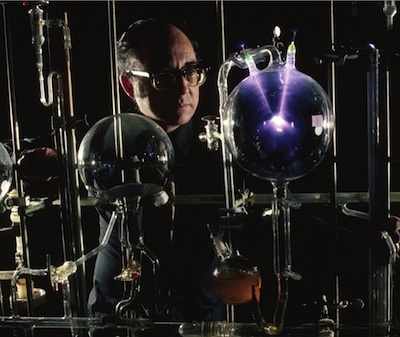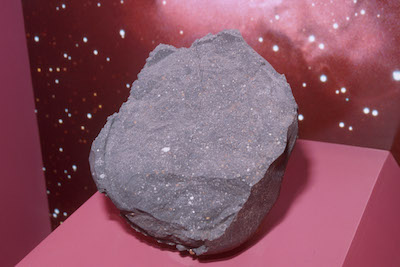Chapter 10. Miller and Urey Go to Outer Space
Miller and Urey Go to Outer Space

Read the article below. Then answer the questions that follow.
As our planet orbits the sun, it sweeps up more than 100 tons of dust every day. This doesn’t include larger rocks and debris, which occasionally light up the night sky as meteors. While most rocks burn up in the atmosphere, remnants occasionally survive and make it to the surface. This has led some researchers to suggest our planet could have been seeded by stardust. However, scientists like Charles Darwin and Nobel Laureate Harold Urey proposed a different theory: they suggested the building blocks of life formed when lightning struck an atmosphere rich with chemicals.
Which theory makes the most sense? Let’s take a closer look.
The primordial soup
In 1871 Charles Darwin, the father of evolution, wrote a letter to botanist Joseph Hooker suggesting that life may have arisen from simple chemical ingredients. Though Darwin acknowledged he was speculating, he envisioned a primordial soup environment consisting of “a warm little pond with all sorts of ammonia and phosphoric salts, light, heat, electricity, etc., present...”

In 1953, University of Chicago graduate student Stanley Miller created a “warm little pond” inside a U-shaped glass apparatus, and successfully demonstrated that the building blocks of life could form from simple chemicals.
Miller’s advisor, chemist Harold Urey, believed the early atmosphere, like Jupiter, contained lots of hydrogen (H2), ammonia (NH3), and methane (CH4). Miller’s apparatus mixed these gasses with water vapor, delivered shocks of electricity from electrodes, and then emptied the mixture back into a boiling flask. The experiment generated several amino acids, principally alanine and glycine. As more sophisticated analytical methods developed, future experiments detected additional amino acids.
After Miller’s death in 2007, several boxes containing vials of dried residue were found by his friends, Antonio Lazcano of the National Autonomous University of Mexico, and Jeff Bada, a professor at the Scripps Institution of Oceanography at the University of California - San Diego. The residue had been left unanalyzed from early experiments, and Miller’s friends decided to use modern techniques to search for the chemical building blocks of life. After joining forces with Jason Dworkin and his colleagues at NASA, the team discovered 22 amino acids in these samples, including at least five amino acids never detected by Miller.
Life As We Know It
Amino acids are important molecular building blocks of life. They are tiny compounds capable of forming long chains. When chains of a particular sequence of amino acids get lengthy, they twist and convolute. The result is a protein. Proteins pump nutrients into our cells, regulate blood sugar, and make muscles contract. Life as we know it couldn’t exist without them!
Miller and Urey in space
In 1969 the Murchison Meteorite plummeted to the earth in southern Australia. After grinding up bits of the rock for chemical analysis, scientists were surprised to find amino acids.
Unlike the amino acids on earth, most of those found in the meteorite also contained deuterium, or heavy hydrogen. As the water in the meteorite contained little deuterium, some thought the amino acids formed on the larger parent body from which the meteorite originated.

NASA scientist Max Bernstein proposed a different hypothesis. As the meteorite swept through dust clouds on its way to earth, it might have picked up several different types of amino acids. These extra-terrestrial amino acids may have formed when ultraviolet light hit the chemicals and deuterium-rich water. Astronomers discovered the water in the matter that exists between star systems in the galaxy, called the interstellar medium.
Bernstein conducted an experiment like Miller’s, only he used deuterium-rich water and freezing chambers to recreate the cold, volatile environment found in dense molecular clouds. The amino acids glycine, alanine, and serine emerged from the frosty concoction.
“Of course we didn’t produce organisms, just the building blocks used by life,” says Bernstein. “But this shows these components could have formed in the extraterrestrial environment.”
Molecules from space?
Billions of years ago there was far more debris in the solar system than there is today. Rocks the size of a small moon skirted around the Sun. Gradually, matter began to collide with larger bodies, transforming planets and moons into their familiar sizes.
While the solar system was still condensing, this debris bombarded the early earth. If molecules beneath the surface of the debris were able to withstand the heat of sailing through the earth’s atmosphere, it is feasible that these same molecules may have contributed extraterrestrial components to early life forms.
So both theories have credence. In fact, life on earth may have arisen from Darwin’s primordial soup, seasoned with a bit of stardust.
Analyzing Space Dust
Did you know that NASA mission OSIRIS-REx will launch in 2016 to collect samples of space dust from asteroid 1999 RQ36? Samples with be analyzed on the spacecraft using robotics and then taken to earth for additional experiments. The goal is to analyze dust for organic compounds without the problems of contamination and alteration introduced when meteorites hit the ground. Find out more at Did you know that NASA mission OSIRIS-REx will launch in 2016 to collect samples of space dust from asteroid 1999 RQ36? Samples with be analyzed on the spacecraft using robotics and then taken to earth for additional experiments. The goal is to analyze dust for organic compounds without the problems of contamination and alteration introduced when meteorites hit the ground. Find out more at http://osiris-rex.lpl.arizona.edu/
© 2015 WH Freeman and Company.
Comprehension Questions
Answer the questions below to demonstrate your understanding of the article.
Question 10.1
True/False:
The setup of Miller and Urey’s experimental apparatus was largely based upon a theory proposed by Charles Darwin.
l/z1Yl7oaTd5t5aAlzVI9g==
Question 10.2
What elements did Urey and Miller combine in their apparatus to generate the organic building blocks of life? Choose ALL that apply.
bI0LPa9lfHQ+dYqk hydrogen
bI0LPa9lfHQ+dYqk ammonia
wCfH0QtRgXJ8o+c+ lithium
bI0LPa9lfHQ+dYqk methane
wCfH0QtRgXJ8o+c+ deuterium
Question 10.3
The chemicals in Miller and Urey’s glass apparatus were exposed to Q2q16SpBwZZ0msvoXeNo1XxXLhsFaKfk6KF9fiRThOkIGmCNuYXSQxpUGRyHSleP5QowzY3UUVNR1f4R1/tFVtabJls=, which initiated chemical reactions leading to the formation of amino acids.
Question 10.4
fGpgD3sX6SvW2Je6frUB5v9kZXpGOmBJLutXrKDxvXmUkM93wi1u9HwRGgs8k6EkLPhzPlXMa68FPjYkQqvm9rGFJfvDN3kxGG4gVy4fioJ8PdFtUElNravlyHXKYJHLT6IbpT5UzMUttgy0DHpLNPtexDqpX+CISOsPuBKHkdEL949En49xU+/wsJauSoAp+mPhT90inVuLn+HY1xIgE3XOC6HT62XEU4Y6S8G8iXwQN8D6vZczmuDXVWdvrh9+La7IksO8JF9io5B0Ha+Cn4x6j1vZ4iIQ0dx7MOATvEJJi8hoeoX+MrcrzPrLCzw1MQwysFK7GB5IJeasdw/vrcSyyacgTqJhqct0q2VEL6qERR0LTUaaQ4/fks3WicG0RAbjy+jfkeJnji13FrDdWfENyrn58+aIU0c0+qBvUIgb6m/RmQO+GSbDjt6sLFXF0ztBXK2sPdxmRjuz7PE5jEWnmJFZV4LPox7pibUzjyVCugusiXtiAxnobdnSmWN1Sk+SLB+iFUToL6/wHFN+7+dNIcYFEFh8R7+MOw5W1tIn6qSjhgxlInd8nq/9ST0VJU1MiT+BmZg2weKNWeOg79TppoQ8MTuMK5ylV1x/Jk6JYLoXT0WbTfO6iA1/2+DokPMwxm9PWIMIV6yV1s2IhokWDrudxgxUCUpIYC0ei0oQlWK9RkEDH+Z6cYNrVuSpyc4bSuMkGY2D4hX8V/JuCJ6v0mz/dZ01YUDx+Zp6TBnzIrzfr1VHyHT8ZVGY9Koy/MvDzrooGSlNsaJTDEegh4iMXt7VCIcVrQ53TSXlFsqSkSAv7Nc9zdls3D7RsJjZQCzj2p1X7BUYEqia07gxXAm9iAx/jc/YHg45yTv15uGQ8BBFN0H0EV0iov23Q3GCL144U0LG0qYiIW3d51Xt31bnYWZjodK6RyMLwB7L1LTwpSuG0PQ0w54+T/x/yswG7ne4I6hPwcWtDnjWfkHc6YWUE8UTcGQhbLogG/cR1ALA+bEjkIhhpOwmyJ166DZzPPG1gONdJsxC9cuqlWQGORHYn8Nux7T94VaUxpgKYVicwZaor+2GQ41EEtGq0yM8vyLoOPI1HHzS3c14r7KK5a9Bkl1EnmQiponzgm9kiil0qWhCMdAjZxdg7fG4LQ4ljMdv2ZFfiGkAwgDTAWQDkBcCu6NnhTrUZu5ZxlO6nDx4K7qpv0RsnJp+KlGTz88BRCvTIlwbbgY=Question 10.5
uxLsSeIyPQq5QBUes6GTXM9BVOMzBgr+68PyTHd2JAEpNtBVZBl/fK8NsiXunuclcMAQWsSXcKWUlC7CTBYyyfErbcFgd3XLBJa3Y5Jf63U1/Rkhg2/d/FMId5zAOZiuoyomJuGLYUZDKow/V3WBZQKP9Vynqlkhq2y6B8UsodoYQQyAMV+zWDb66rUJYNa5qlQX/VgAjBatWAlfGcvs43sdn4tIrY/XFnSbCaIsIAFMUUbYdL9kE83ioEWE1xoL9DhbgjrzkyN2H09xuZR5TZfGupbaGfGCKcFU6TOEJZhtA/9wtbhJwM8TX9Ol3Djv6M1fpibGKv7cFmUI5hl5jCHha5ETQQ8KPToY6LnWs697L5Pe6Y289E6bkwEjHOtl1MTyG+UDeXbLWxhdgXhybzJWUpleEuvMKPJBmdjRmOP0ZnWHHO8cWaHGSb/PNHDXdN1N81brzMN5Hn4iE43yOiiLMpRofgtXtRKalaFwYhyMp0he7lk9wJO3vKomniDsE5FCd3lsnXBxE8LhJBp/xdqdsA4bEMVy3HT7mCClJdqhZVFT2JOPHTBDA+NyyEcawms86wgIDUkDdN0r72+2Qh90iqg7oNNuqkcw+MUWAR6rAu+XpRa4uYGCEGCTlGVONLn1kfNRBWZhA5zuwSa/kzup6yNlehITOxkO8s3xIbFfCsk6HnwigHsuhkCYNPOpaXDqoGOrZPhPsi71ZUS8nfZnvQHIziEOMp5OvFWF7TCjqDVdWEC88tNjnbTSrYVs3PoOnDrrDGrAepUan+4Qr+j/vnjLktaxFuBV0VBZqSTtl9XsANZgjiBJz/0arMf/H4ueTsukqKM7uzFNPFrYhTnoOLUedofNB1NY5XyZlWmVyMAATqtFgLVDr1yk3hBL+jIUeCMDRxKkVUf/sUjkH9XvF1ZcMgrwuabGmnJWLAshM5hTbS4JoeCUjHe1vZZPnX/zeQcVlAsol4ebCPHLo5vZC5phK6eUu/CaZu129fPSMxddN/KkdeezRRGBh6SWSN2vqJahQPFZacVm8WBuOnDNEoJWO9w6btm6B5TS7teX7RpepjvmAU++Sr996HasTgxqertl/ii3FjbZAIg0qmrH8BdOHwiO4DYV+1+Xz1G0oVidO4Gvv6Td40frRnHXc1JVsKT8dGn6+GbmCQe7NNNIl71mOCI8Fs7kVr2LNAutAD4Qf0v3kiWD02ZZGYKqyYiXNQbpd2CvOwrv0n1+I7jUKqDY0Nsubi2TFn0xmYyqVIc4rZC26OSaVQLEnCSFBL60LzZRTojSs13jrRxJMJ846TJgdYCN3UoF1OYK7281BlicHIGjeDZLGONnYOJnISQyVyKmle445XZLU0DWQLGP5xGUn00/0F7PBlNvTDCAoQVk+Etg08RGN1BOKpC3VK7RS9dcsJHTFBp9NZruqsrXhEq0xmowseQ0mrCgV+kmAwXMp/6+up4qTQeHVFkfTCX6yADzUtuXskGx0M6xK7TJTgCzxr+rGZBE8HouoUzbLwe/PfcQbKkVv+u5BYrTOTccAYPxcks1juTt/XVHn4rAi9XLpm7lXi13BU4R+UidVMM0E2Qj2L2Z9HyKSvarTjUr3Q8+uObkZrhwVxYep7uN0QYl1WTjIJ0DYfPWbBcf7AiWOstLmUWOO0g0JGKT6HKdDmSw6B1yUSEzNZb58ASEQo+svXhbiRic29wJLisJaGaaNL83ifLW6C7pIX0HNfAbO8uSwIfxKwmnksoO0oVKOeF3neoSISaBvYhZxP3WaKfzigJs0ErpuTjszFiYCFUpfUeDcMfemiMBNKrAQrF6rO09J2Ao9D+ali3IXXk7TI0OBEzlJt8JZ0M9P4BEiMoh40rERf1lBRqr+swJxV4OXebvRQ/TzkbwpA1n0+8mjNI7mBhR5NfusV39t6nQP4wmf7FFc/0z0IsvOhDBOkymqCzqoNa7iX7VSNJneLNvJMKLf8gTVTnT+6FewM7cnCy/FoGTBoC6/RFbig0La0qxNS2Bs6lwz4eUkbr7+vS8MJ4bkKK1HWJvH98qCibalPcLmGUJeYKnJUryXk3SxMR4xw2cGyTKM1ltL3fQe3esdxkeMPTaXk1e0BLrFy0RC+ehmlhpQHYfY7dOia1ddEOIvrl2NbvpEok6rNZ31MylKFJCPJnRHUXRRU4v02vClQJWj50PxfFKX/NveA3giU8YPo9fMLjYqjBO1QvZ7oYxu5rkjYkeN0fWa6kvB4mI7Bp/AmXs9BG7yksbYwXGnxkp7NL4MUsjeiLhOxKyOwSOrC8Wv1sj5MtEKl76P0gD3KtwWxuRiyIjFjYpyyfldRYjs11B2vXGOpwxAykcDed5pE3RFrkEm98PBazFcRyRysOz1VO1yGbxpcNH/gJLkeoKhYQslv1wis/QNu9rDJLC8LWXttb2C+xYJ8cHfSJAsEvj8Vlz+pZ1dzGKPkUk4FcVi1W/KDgeJ1N3sf2V03DB3eRL9qBt9JODLSnfJ4EIeCTJ0vjc3ou4P6hjYK+fGfnWC/PDeEk+18w3M+ody63unvoLDlRKQ1xdlqqeqj4t8rN7fHCjnv1+xLmASKJSIM1LTXR1V3kzfK43ZXYavg1rx/8ujyUMpUCPkgLsTQsBQuestion 10.6
5h5rHhB4rl80DRFkrVTYZq6MtijA/q1SM0+fAxSJV9vYOVVuhaIBYar8HDc8BCqvwixlyl0k5kNlNUurGLUOqomUejkUso775DgLRpBEIhreo4XQgqDNP6nq36E0cQYiT+h4c0GRD9nVr8SfmowKlfFvq3uqgu8vzvdem4PbWHzqNKUHFQnbwY7eUSJmjQChZLpyeaujklbETQiqzdFeErwewBm1p6Q59l2PfrLrztJlGtOYF0Uaduq4OFMRTKS+uphrL4Ro/g4KnH2wAZhpcb4ptyDI/qQeyljnhnazyCrVz/m7nCJA5ZJDPoi/cUWbthobYdaUaV+u7QAKSMgc9Mg5ta5WVxrEUQhIDUnFMrwwFpkDO88mqzdx1G54w4AbxGqOCFd+Q3NkDOiSQsA1yBCd/v/y62agmgVnNRw40CWVfTs8HsX2mzrWGHAcXQxNqoE6y19t6EJEZwnnkZMC/rT+OGVuZVnDxjZvre0FkF4sknKfDVGrPRLZIQU0bmOnaSp7PVsMrMtyr+xyHnN19ggdc1tuKv3K6htVYxTrAztz6M/jFoWltYfFgFQyQ5UlIBQUMbHi+EpYuM9bfIbqZbvSHOm9FpE3UBazEJWG4Fzxpvk2SguJI8R1Z+ZvqvryFpL2B1xUPVho4t+C8t2h+oPUPm8YpihlHNptUoogIFAeXxo4HXpQ+vxtXE88qQyYP0/eKqmYJs2NVIng4Gg0BHyK7uEu08nd0ZUNvN16p+jeyVgdNW/s1ApzLaT6BRPOHiOuBJem3zURldLSbh8mCwtSzqYuITZZg1WdusY330ryMWnr/9Q7a0v0m6OrhlOzDYUGm8EI4sJ8/GOo8WhYuytjlXa/HbAy7ZjCA5jot9sZ+LQ3gnmiRWEXtXcbcsUeFG7k2Kj+Fe23DJV/KaxzQNQlXWb9iJYWU2wdM+cVm0liPWH7bpiPwZQeWUQrOfFQiHWmXRnyGQC7F8qwxpEC6SF3+rek61zYUfExbzm6qOsHNYq20OdYMXUTABWMLho4jKDJwkbnvkkBLfI4SlO5S3H3W/bFHsUdlhDKETvabQNNNjqdQqnA8qmev1ljBexewdjmLHtI5KryUVCN8mGvCJP1Gafb4sTpHay5tJpXMvQvAysTQRdm3vvQpBmr0m7hOvBWUX2t9LHKSKxH3WQdPgGwklx4FtCIsnrkES+9oCZrytpGrZEF9TRlCjDiZY2Ad2PlRPU5SI1Ai9VADmoOS6hQjNas+kTWi4rbPsRnrEWaA6edc6c/MVP8S5RacgUKG9C1VkLrDRhYIDoAlQPa9md2talAl0sPfqHmQ05abxh0EZMQS5Jj9SrnMy0RqQpkL/jz4SddiX4YKIf7QsPCRuDJ3L83PvFFbvKA5gatYkTesvE9Ug45eEDwDbO0kpW9Momt9FJy6fGiL3goDppHEhpL/Q3r4BTmE7JTsgzR4d7CamHRT1w8v5CrO62LjDES/9SuxG9f3cInQnAMWrssVG+u0eSyzPHzul1LV3+5dY3maeyHfRcIVLHbe6kIDxJ7Jn6SPJ2UQ+fWK5NqJGqojl3GjERDtAiAPEbnS5+MxOg+fOpIHVuSiqzS1cNHxFhPXDSuO3OrHnIyXAPZf8QJS9Js6aOg5ssJpfFjpcysvuY8Kqmw9i/YPYS6AxoInCj9ybhCbNjt/1XNmvHEstN92orptxoWekRwd2q9kE07bbpN/3YuZOrUyrlWj4LPr5GJzK/ChfD+I/CAz57OCjYClXtfxIEqFD0u6SJIOiMtukO++n7fCE/U9JJU9GdE37DBYyEnntx9TSDkkzVZ+j8hTDwWyz/uXSUDz06+qyqdSn3wQZ9+aTS/txl/+6VR5XeqWUdYC+RJqg4aW4OEX4t8WietIsnSPiJ2TANV37HgfVSIrs778WLyV3I1EAyxrgRodfI/JUEtH2eqkO5cQuestion 10.7
Scientists were surprised to discover amino acids when they ground up small samples of the Murchison Meteorite that crashed into the earth in 1969. Of the answers listed below, which two correctly describe explanations proposed by scientists for the origin of these amino acids?
wCfH0QtRgXJ8o+c+ The meteorite was exposed to high levels of heat upon entering earth’s atmosphere, which catalyzed chemical reactions, producing amino acids.
bI0LPa9lfHQ+dYqk Amino acids formed on a larger parent rock from which the meteorite broke free before being carried to earth.
wCfH0QtRgXJ8o+c+ The meteorite was exposed to extreme low temperatures that could have catalyzed chemical reactions, producing amino acids.
wCfH0QtRgXJ8o+c+ An asteroid collided with an unknown planet, breaking off pieces that had amino acids in them, which then fell to earth.
bI0LPa9lfHQ+dYqk The meteorite swept through extraterrestrial dust clouds on its way to earth, and it picked up amino acids that formed in space along the way.
Question 10.8
Ay5tvM8ka2S+1gYdr9m6VvkUEnaY6MSjCf+ykWZlRej7fdFsU1FOCDsu1N2sqDOR0jXGlzHsVLRq1hmaqMFbVlwY1mjY4yCSG/ziMfTk/7zmBVH+q65NrOjAk5nLSkpK0Xswzi853XlEqZXQlWiRDUlh3PjAR9zhQY7SCZEB47WR4Kqy8zAXofVflBOV58sDWm1Bzk3rltt4llc4IB3PURoeA52JohMSwltUKmTNA54aXmRphPd+OLGOQLngfvm5TrqfKjXE6Gg/mbK8mCpyolUL4640/044wf+fMKrT8zlXOeJUulN2i0ImW7zniBGlu07rBwc8/qdFDEJgTZL4nmo9Tr2uCYfUvCK97e59yAShCIsctWzY9sahOZBhosG1a7gQTD7P/Gm4HZ6thTCo+xk9R4j49xbS3MvIYOxIIKWnyZnYeH188I96IFGGQsu2gc0id+W4Pff4FC9xY1nVbrL26ekRCJhcZoFfXwXREqvinkAhRhX+LfxxHi1I2zpyp43t1wRf5kPzr38hWq5qKwZJD9qX97HdLnSEKCQ29mJ95JnuWHCR5UrREBlAtuQPRbVcmKdGzQh6FBZwkiOZOl6NWH4OcR4LNEb93H+sED+yN1smoeovqN8OOojFMMmBFjSnUId9XjK4L8fjwCevOF+KGp3Kd7ExGUWYbSOJB2UxAB8kCzIgjaYmSnXydj8/6dQJx2eEYgk66FgJ8ZLDctJQ4VuTh2/cVjepeGbFGZPE1pdpAl0h2vTEW766Ia763CkO048CfoFsh6UsbWp3qy6rMp2VEJYWwKooNbtPgYuE9DC+lF2gMDXwf6JCwfbA40yF5HfeuoNlj7ONZUU9iqRZzcP1wV5BVref4cbS8ixUdsSCNSS3w4f0bj2qCJTcew2gztT67yYU8oRTmlCndK+e00rz9nkNNoJfUC/pi5fRjGPzay7UZg5myHd453m7FAD8n1xrKKMIn7g7tuLaBE5XQw4NmZp3ye1g7dEGO6ggs/s/pE4E2KPkSU/pVVaomkZmutWmNPtwX+yftfjC4019/fwwC57mC+91RoGKmPvNG5Jtn4bU+84aIxcWlYd+eJKQ7kSEokQvSFNifxLbnTOiGUWTmKrh+CrBlAzqzUt+xpBCDr7v27Pv5+/2rnBiNBSCa4KuEk+1WDjI9+FxcSHedMtcF3L/zxcB6XtRpusSJdsfGCnA6D2qx6xOiQfHyCrap4sGpzGH7oKABdiG88hG1SLObEtAdpx4sEhVuMO68pck58tbTWqvuvbT5BW+yQzBIwscpfkqiBAhnnSzR+WlPdq7qJDHIlCi6b6FH58QL95ibmZwhX5VplqMXieFzmjSMdS7vDZvvqF0ZgWg1gVuccUUqL0ZWUgomYwd5DaOMIey+fiRLXpC1afat0aOseivz1l6sQbz0V/eeWH0Yc+fyp9+nUjdmWRY7AfdVNdb1dsD1hBH3GWRG+SKP4StETACZ6klQTF0OCwJ62mC8k/jTlLk2hbpr2QVTazdAdu7GONTEQPqvYwvFngEnfRs5CVli9vS9NwGwKg9jO22ClYdRHNWojM2juVkBO7unrPt3jl+V3z11JZoAzeefCTAoeYEgo3m5fLG4ogh5vXztp5Wo+oWzKZUlq0R71BmsQpaA+QYhvIBR3w8rbY+wQ8sP7RNWccSYp2kE4XarxZQRg==Question 10.9
Zj6RTf7meDuutLnR3yRGMsEL0CoZdYL0pqqVu6Nt32pzmrhNit6nKwj9NG8qGO3MSpweLjrdZ4avMcsJxQMRQ/G5C8AYURVgvBsvFOfxt6jVZEzBIh5XgYj96GeDbVriB3/MPV32fQvbFy1T+AUTjFBYRyWtjsEJWl10rUzpmhUIzx2l0W1ibSF0Jr4jTElHOUo4VOCnUxF2eHkz6qI39jyhfo8UGMPkXysu8mCBcLQiy5MF54rThl02yVsIuSyRGpa7n12dbeoIhEMKu2ynATeHafh9sKp9ZtVHVScqvVEoSWB6EUdNkkCTYaH8ARzYU9KAPJ6/3sTOrQyk/YbTngUzFJKstAaUFeXhms4SvtuOoDjFEdOyf2e0K6tlxleQK2IS3fJaijAowcwIaD+GBscutT+eAB/y9kbXWym1CVpIZec1Mbn5bP8xBA/aqsr0m1H3pM2g8md8hkuvwUd0ktfIn3Ekqy1YYvuXiKaQkQH0TSw4/wDuAxONY6qt0AUTUSXNDePiB3VpbwttZD1hsvdDCKTXHfjGeWc9PpcmH0b2ofmzorjxiB5HVfEs66cNFI9g1d3M+VLMbc0vkwWPNsbmY1tmGd4ghGWron9lnEF2QYgmEyFcoJPq+Xm7w/yIR7EkjumdHcKP4ULQs27Z75PVxBrifNo1kjpIiGRRFmRh2+zBbbjmro6xsaRwwTT6x/zQsow2ahtHSby2eSYnMOr03l/to6W0OfhbvELgv2vPPxxKqIEyeMRvqBcg3KZOXkL0VY/o4/A2UaXV0r+GMfW3JcnYECtA3pqcc0+/n7VfpPOkJ32WjWBE2b17/pLwyFV2mNo83xlqkYAEC1ktG/OtU435waaUCUhr582Fc6m68h+QqA4R9j8B1vzkCxiripvrP1nGa7/C78lnMCqAVloCsQVeJZKTY0hxeR9c10FBXyf6jAroXUFwUWuppNmcYfG/72fUZVZdMH5lrdQAMYzCG7HzP3P7ZqLDoBxDVWG9P0onlCR4CdSNEW6qfRRcsqhgGJLFOVAgbYhrqbvhnmHjFOwTIFYIbbJIT/BvQ7x4O4Z/Ncw+kTr8yyddQI3Kw+JpB08OEyJjyq7PLsv8BuLJfvj5UbpLzm3mppSsBUpv06sKh1dpKeraTdnC/fNsW/tvgSyb9PMqTv8b6eCndoLTZL9Js38IvdXEuR/sCcE=Question 10.10
lsVoQ1zxaddQpnZx49cDc3jcXklootr0NV4pG++EgEfGLvxljJQSuBzXcSbHUmhGSp7t9tpQpYI2CYPMcOsGOyqYoabQtQUr7WvqeZxaSk12nsBsNwIZwvGkGJKc6hJcQq7FgU9W4Yb3X7FNvOo05/DWb+aSEwbfeeGOtOOe76dmXBTc1vc6pvaDx5wm6tczF1bdVa+MRfZpO7iwbjz5FWYChDfYX+lUvvPA/8dKnFGWRizK2wb6Kh386RICdo7UCHNewDhM0vUqzMIO2jnxJX4MO8d+7weVT34zpSgxABlgxxdCdmKsIgkHUkY9Bm/FxoDrWBnHQoJI4hr8HlW+UGFTeysySoWZP3rHvUuooRVCabszcjZSpT40/rQSYp1XXLc9SXczo58MVZRRZANTY/7V0AhA8cJRMlCPViLIPTLDVZYXQVZnY/JMR9FINZ8v313MSTLkNSrEbERtBPQsF/Hhs0csDiLqvLdrim7Nsezc1A0eNsBdL3vih4uV/pa7DVrpmYqp8XxCpUVa8eHMBXDC8Je1rifHJ9851gSlhGqRDHHSylo+WjDoViy2yNlzQSm90ygoGElNXjdEB1bsPWuEGGnuBIlXlSBSeryhXNK37zwipnUv8F1bhBs3GO2fibcK6Fnfe/Ojf93ej3DIzfGk5Pu9uqm8D8hMM9TeCQiD6pgLr50etiNuDgVB7R4/mJKrrucJ0JTNBNFsFbt1fko6Kwb9IRwcTKYxuqMcCXMC7gqyQtqKomw9dd4tmcwm7fxc3X5nv+fIdM5XPmKUMVMcl4rF/0Qw97zBAMHiNRlThbRwcJMXnA/u6iYf1IGvVAN5nzvy9Ft47bmO9N0TXTIIg6CVKrKQWm52WztQ/T2kCodsrMnn5sTpFYW5o1k1VdJTAE5fqvOWB2KT7aEf7Qp46I8pKLQSrosWL9MpGs+pwV4fc0ScvUfdDuvNJkuaEr8jeZh6VomJTWx9yksX1mbAZopbx71Y5JcvE9maveei2w3XprSzU8mkU//yR4z3iW14UsIVLbDv4APRNC6CGuOwmK78L8/Do0CuSO+sah1vm107u089EHxr1EKyBCK7TOX4Olpp/FveCb72kKEjuM3qUbqmxRTjoYC2ne9TGF4KJo/RFyry8OQIftkdaNA/ZqIiwz9G1Y96h0FYxInXtb8wbcct/Epug25YpPj74VXkb9RHRoQqNr/3PHeDInso406Y+QsOKLpDF9tf9PB5VbPisOKzp4qFXCzKAOK9koaWmQ+yP/+LTG2oh31Gq1gpIGgQX6Fwx03IQdw20H4hV0EOcKUzoytTpIIsa8duxP8wKJWX84aACeyF+s7KkuemeBSk0KCZEbGj6MwOzipcRTWuqH/TZr9cAVcZkNiECyCOE5EHItuWFv9srrjbw3RtikbII/KzeQzs3Jt/+mK6SKxtsdHDgH3E7NjVEAJOrMESknMgq1/ioluQtu+xoiJG5aqaKeZbAhjuvyfpVZBBoYnYDFLQu0/nkAH2v+YP5eGDZuUE70VpVoagxu6jqk2pXUCJA0vg5ggSAwDGE206VAin0KqszE6KXAxXSOzwnTMCXmDk9Erfm2RJX1c6MmzwtDlLhGfmbChb2nwfc1NpahEioB+L8NfDc/V9vCCsC9nXlPYliNwNvAsejwmA6dX1seV1szYqnNykpVf5ff+gZw/+w+QvX8UjLbMGcXNWOlc0UrloEmIO9bRY6olostFpiSr45TegZ13gTrFQNMJ3mHV6i80ciOfVxO16thckuFJv19WGv6tOLR6Mvso7sDPEUvZfEPjG0ITk+h3KvWywZRFIS+o4RwCQ89Qf5BVnAKwwq2SwDlrUypzdpgE0awDWcHDzBQ0ceL3gPW0XfF228uaEKISkzVjUthI3gjyixUcNeEtW3NpoGW6EJfxVnT4elsAxhvtdlTRpz94uBmZTh8n+o8ZcWpyjq1rMBn4YI5T9k17tkmqPfUYwSVoi5XgRMB7pZYNHBM0wdwqJpRIFCTjhMvj958pSXLVf8tlmC/49zr2lEa8xChoYoiyE+ZeY+aUO6e8Qn+VPWUgn47aAkYhxJoGf3sKYvdhdeBaWbeps1kcW3tBRlyhhd3U+jrv4o29vwhEtBPSjlN7vMSTjFBwmtXIjp5CRWr2N6Wi4n+CPxqpBPhmz1zIeZi2xp5dp30P1xnwbZAAwu6qlGwIhsBCFHG8q98WhOk0UmyLJTwdQw+9fzORjJUvW9VGhpl69J4omuzDwIhpmvno0Zbne00KD0IpziXBWuuTBlG5exbqf7QaQkTHz5jfKamUmqUgxWIdC3TGRbwLiOjzSTUYjCycARxQENHJEAvJxeGMmvqiwjWd5tZRhvtSWr5OWhCHwGGbRUnAAN27WUKRxNJCe6ruTL4ywC6t3Kvs/n8WlUshxMfWwQjV88bMRFtX+AMHt4cqSHg5jZcqw1ByJQV1jY9gox2NvIXtt+Fo/tmhXWrANwn0WemzZubund0IgreATN2nwuzeJY0oS+aqThdCwZU8ftY2KfbIFKZ2pFhUZsMz2qgg2hvtYLsqWj7tA+vbg9Jr6IJ3jWUO6P54DwlkmX1/aelYGREp9HSiEej6lKNaIUEH1JXexG6sWDJW0/iu/Jo9CVHs3yzXHxsHDKpDEsJhAUN3wnkDkk+YgJ8gqB7eBiB44AsZ7C7bqXSru5J5aZY7+rO6nbsQ2VpiLnevA6ZM6QpjExj+SqHQZkIJ7dAAyhC08I3J1RKnCXl2oQYWKxQ5GgVoUOjAtFyGoUi3Eqgmh5YaQfJO1ccWHpt9g4kcUmvFX53XEFb5K0rzcV0xKKwRyHea9rd7H7tblvCX3C1tZ7nkL9DQtO32RpXT7IJtH5G8rxHAWZKQw6vctwlQibJgERmW6Vn1q8PpoXDCY82J2St7RPHwFwsJmR4zv+169TEtdoM2dxECZVMqNUvPO8+fyojojgoei9jigsKjuJIP+VDvWRp31+KoHc/shrgG69UT0bej42x6lA+S2ONZhAyXBle+iB/wyDeu+1gfMvcUfUozc3NU2qD95HEOZBJ6xDwPmdnk8zmW7hn016ConXahFp++W8z6WRSVnActivity results are being submitted...